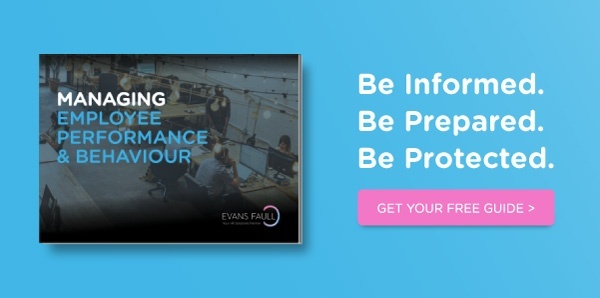Best Practices For Managing Poor Performers
The chances are that you have an employee right now that is not meeting the required standards of performance or behaviour. Such employees have a direct impact on the productivity and the profitability of the organisation and depending on their role, may have consequences ranging from lost clients to safety risks and workplace accidents, to the resignations of fellow staff members.
Prevention is better than cure in the case of poor performance. So, while you may be in a position where you need to be able to take corrective action, keep in mind that developing strategies to minimise performance management matters is the goal. Employee engagement is one such practice which should be a top priority for your business.
Why Has My Team Member’s Performance Declined?
Employees deteriorate for a number of reasons and before you start the process of exiting them from the business you should consider what got them to this point.
There are some obvious workplace factors which may negatively impact an employee and their performance including restructures, workload pressure, relationship conflict and lack of skills or development.
Naturally, there is also a range of personal issues which may also lead to changes in employee output. The employee may be disillusioned about their career, the organisation, or perhaps they are just bored and have become apathetic about their job.
Turning The Employee Around
The first objective should be to try and turn the employee around. So much time, effort and money are spent on recruitment, onboarding and development, it would be short-sighted not to attempt to salvage the relationship.
The starting point is assessing whether the organisation has been completely clear and transparent in communicating the performance expectations of the role. If you don’t have a position description detailing the responsibilities of the role, you are going to be hard pressed to terminate based on an inability to meet the requirements of the position.
The Fair Work Commission puts the full onus on the employer to communicate what is required of their employees. This should start at induction with the issuing of a PD and KPI’s and continue with regular one-on-ones and annual reviews.
As soon as an employee’s performance starts to fall, the conversation needs to start. In many cases, the problem then lays with the manager not being proactive and avoiding difficult conversations. Subsequently, the employee continues to underperform, and often the performance gets progressively worse and the manager is left exasperated until they reach a breaking point. By then, the process has usually been handled poorly, emotions are frayed, and decisions are made in haste.
Underperformance & Inappropriate Behaviour
Some typical examples of underperformance include;
- The employee not carrying out duties to the required standard (or not at all)
- An inability for the employee to meet reasonable timeframes
- Poor communication impacting the output of others
- Failure to meet client expectations
Inappropriate behaviour requiring performance management may include;
- Breaching Code of Conduct, company policies or company values
- Disruptive or negative behaviour
- Not treating employees or customers with politeness, courtesy and respect
- Inappropriate communication and/ or team interaction
A Fair, Reasonable & Just Process
Your legal requirement in performance management is to follow a process that is ‘fair, reasonable and just’. Despite common belief, that does not require a ‘3 warnings system’.
In simple terms, based on the scenario listed above, your process may be as follows.
- Communicate what is expected of the employee,
- Give specific feedback about their behaviour/performance,
- Counsel the employee on their inability to meet expectations and give guidance on where they need to improve, how this will be measured, and in what timeframe
- Issue a warning if they don’t meet the stated expectations
- Allow the employee to respond and give them time to improve
- Further Warnings or Termination
If you followed these steps, then, ideally by step 2 or 3 the performance has been corrected and there is no need to ‘break up’. However, if the improvement levels are still inadequate, you have laid the foundation of an exit strategy with the employee and you need to follow it through until the divorce is finalised.
Termination
The way you handle a termination will be scrutinised by the rest of the organisation.
It is imperative that you treat employees respectfully during the performance management process and preserve their dignity during an exit stage. An employee may be lazy or incompetent, but they may also be well-liked by colleagues, and your conduct will determine how staff view you moving forward.
If you document events as they occur, act professionally, and follow a fair process, the broader organisation are more likely to be accepting of an employee termination.
Take Action With Confidence
In my experience, a fear of litigation has resulted in a general reluctance of employers to take action when dealing with employees who are performing or behaving badly.
There is no doubt that this process can be confronting and even uncomfortable for those involved, but it is part of the gig and putting your head in the sand is just not an option.
Managers should be up-skilled in performance management as soon as they undertake employee supervisory responsibilities, there is no point waiting until it all goes pear-shaped to get yourself up to speed.
So next time you hear a manager or business owner moaning ‘it’s impossible to fire anyone anymore’, do what I do – give them a sympathetic smile and respond, “it’s actually not that hard, you just need to follow a process”.
If you want to implement the HR solutions outlined in this article, book a call with Amanda to explore how Evans Faull can protect and support your business.
Share this
You May Also Like
These Related Stories

How To Attract and Retain Great Talent in Competitive Job Markets

9 Ways To Maintain Employee Wellbeing While in Lockdown




No Comments Yet
Let us know what you think